Manchester Road
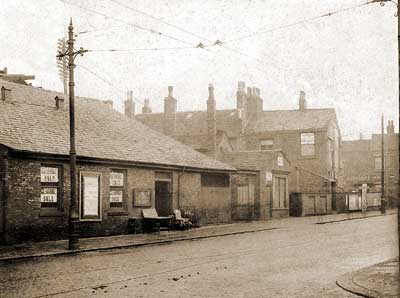 |
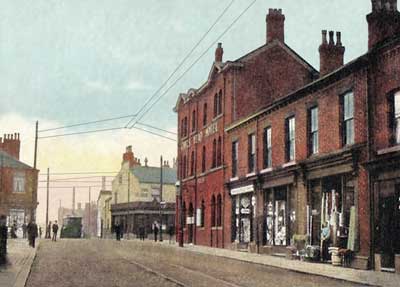 |
Manchester Rd, early 20th century. View looking eastwards towards Crown Point from the corner of Market St. In 1911 the property on the left was occupied by Ephraim Hibbert, a furniture dealer. The small property next to it was occupied by John Taylor, a flour dealer, and next, set back, was William Berkley Faulkner, a blacksmith. Off the picture to the left was Joseph Willis Garlick, an undertaker. These properties were subsequently demolished and replaced by a telephone exchange, a shop (became John Hulme's tripe shop) and Crown Point Buildings of 1916. In the background on the right the Exchange Inn can just be seen on the far side of Ashton Rd. |
Manchester Rd, early 20th century. View looking eastwards towards Crown Point from opposite the entrance to Market St. The three-storey building on the right is the King's Head, which is integral with Victoria Buildings, and it stands on the corner of Manchester Rd and Stockport Rd. Opposite to it is the Old Red Lion on the corner of Hyde Rd and Stockport Rd. The building on the left is a newsagent's shop, which is part of Crown Point Buildings, and it stands on the corner of Hyde Rd and Ashton Rd. |
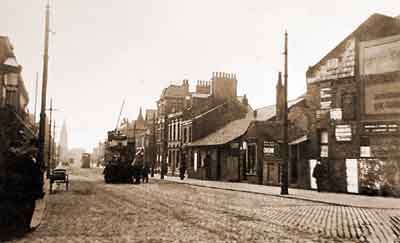 |
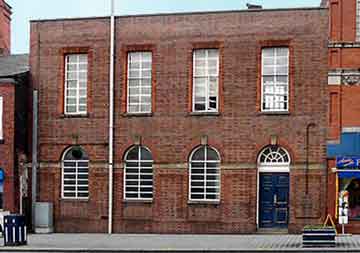 |
Manchester Rd, early 20th century. View looking westwards from Crown Point. |
Telephone Exchange, c.2010. This automatic (dial) telephone exchange was built in 1930 to a design by the Architects Department of H M Office of Works, the client being the Commissioners of His Majesty’s Works. Telephone wires from commercial, domestic and public telephones were carried to a central point known as a telephone exchange. The first automatic exchange was opened by the Post Office at Epsom, Surrey, in May 1912 but it took several decades for automatic dialling to be rolled out across the UK. |
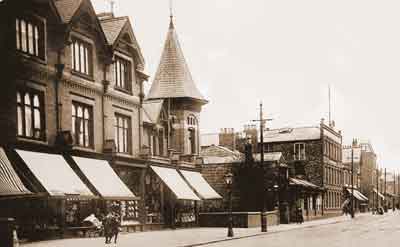 |
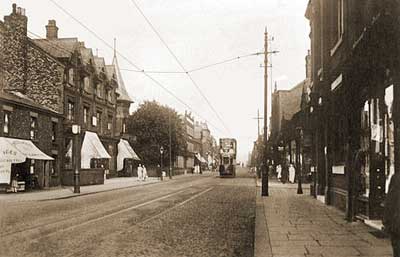 |
Manchester Rd, early 20th century. View looking eastwards towards Crown Point. The building in the background on the right is a hat factory on the corner of Ashworth St. Up to 1912 it was occupied by Higginbottom & Oldham, and then by T & W Walker. To the right of the spire, by the low wall, is the entrance to a doctor’s surgery that for many years was the medical practice of two MacGill's, uncle and nephew. From left to right the shopkeepers (1906 trade directory) are; John Hughes, fishmonger & greengrocer, William Vaughan Ltd, chemists, William Wylde, confectioner, and Arthur Duffy, draper (three shops). |
Manchester Rd, c.1930. View looking eastwards towards Crown Point from just beyond the entrance to Gould St. |
Left, Dr Wakefield MacGill, and right, Dr John Sylvanus MacGill, uncle and nephew, respectively. Dr Wakefield MacGill was born at Musselburgh, Midlothian, Scotland, on the 4 October 1868. He married Elizabeth Whyte Maxwell and they had four children, all born in Denton. Dorothy Jane (1895), Elsie Isabel (1898), Andrew Maxwell (1901) and Margaret Agnes (1908). By 1895 he was resident in Denton. Dr John Sylvanus MacGill was born in British Guiana, South America, on the 20 October 1900. He came to Denton in 1924 as an assistant to his uncle, Dr Wakefield MacGill and two years later he took his MD in Edinburgh. In Jun 1924 he married Dorothy Bardsley, second daughter of John Arthur Bardsley, Chairman of J Moores & Sons Ltd, hat manufacturers, at Holy Trinity, Gee Cross. They had one son, John Bardsley, born in 1931. In 1939 he joined the Territorial Army, serving as a Medical Officer in the 2nd Dragoon Guards (Queen’s Bays) Regiment. In 1937 this regiment was mechanised with light tanks and it became part of the Royal Armoured Corps in 1939. During the war his wife kept the practice going with the help of locums. He retired in 1970. |
|
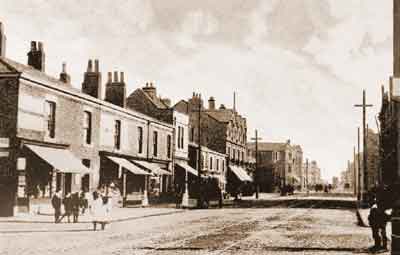 |
Manchester Rd, c.1910. View looking eastwards towards Crown Point with the entance to Peel St on the left. Around this time the shop on the Peel St corner was occupied by James Bailey, a fismonger and greengrocer. |
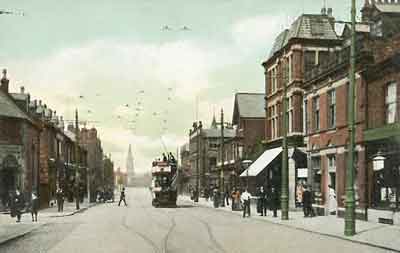 |
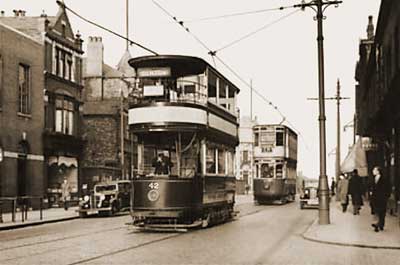 |
Manchester Rd, early 20th century. View looking westwards from Crown Point. The original Denton Branch of the Manchester & County Bank stands on the corner of Market St on the left. This was replaced by a new building in 1922. On the right, the lady is standing in the doorway of the Westgate Cottage public house. This closed on 12 January 1928 and later it opened as the Midland Bank. In 1992 this bank was acquired by HSBC Holdings and in 1999 it was rebranded as the HSBC Bank. This branch is now closed. Christ Church is just visible the background. |
Manchester Rd, late 1930s. 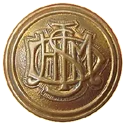
View looking eastwards towards Crown Point. The nearer tram is SHMD No. 42 (Stalybridge, Hyde, Mossley and Dukinfield Tramways and Electricity Board) and the one behind belongs to Manchester Corporation Tramways. SHMD tram No. 42 was introduced in 1905 as one of a fleet of 15 trams numbered 41 to 55. Initially they were open top but later they were fitted with top covers. All were withdrawn from service in 1939 with the exception of No. 42, which survived until 1945. It was based at the Hyde Tramway Depot. |
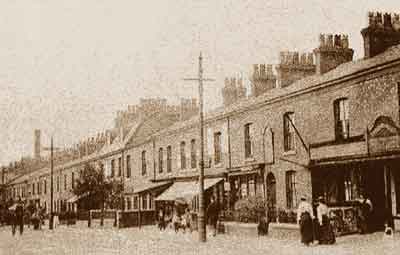 |
Manchester Rd, early 20th century. View looking westwards with Thomas Duxbury’s Post Office on the right situated on the corner of Seymour St. The 1901 and 1911 Censuses record that Thomas Duxbury was also a newsagent, stationer and book seller. Thomas Duxbury was born at Bolton in 1869/70 and he married Annie Pearson at Stockport in 1894. His wife was born at Heaton Norris in 1870. The couple had three children, Arnold (b. at Heaton Norris, 1897), Benjamin (b. at Heaton Norris, 1900) and David Allan (b. at Denton, 1912). Credit: J Marlor |
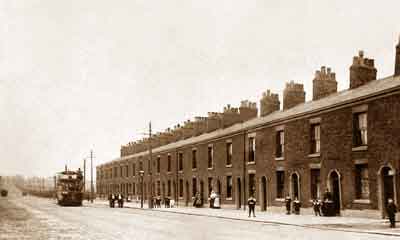 |
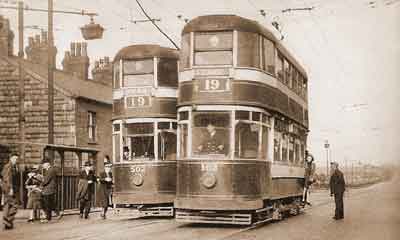 |
Manchester Rd, early 20th century. View looking westwards with Alpha Terrace on the right. At the far end of the terrace Jackson St accesses Water St at the back of Alpha Terrace. Beyond the terrace is Denton Golf Club that opened in 1909. |
Manchester Rd, 1947. View looking eastwards from the Wilton Arms, which is off the picture to the left. The two No. 19 trams are stopped at a fare stage. The tram on the right is proceeding to Exchange Station, Manchester, and the one on the left is proceeding to Hyde via Crown Point, Denton. Trams of this design were built between 1930 and 1932 and they were known as 'Pilcher Pullman Cars' after Stuart Pilcher who was appointed General Manager of Manchester Corporation Tramways in 1929. |
Hyde Road
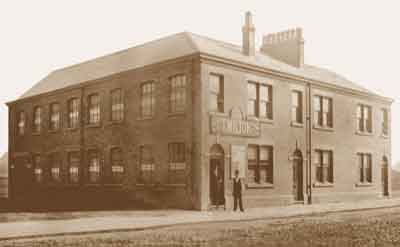 |
Hyde Rd, c.1900 The premises of Thomas Milton, printer, engraver and stationer, to the right of the entrance to Nelson St. He established his business in 1857 and following his death on the 24 Mar 1900, aged 68 years, the business passed to his son, George William Milton. Thomas Milton was born at Radford, Nottingham in 1831 to George Milton and Mary Holmes. He married Margaret Rylands at Salford in 1856. She died at Stockport in 1877, aged 43 years, and he married Sarah Jane Moss at St Lawrence’s Church, Denton, in 1882. |
 |
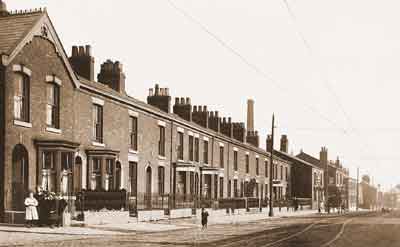 |
Hyde Rd, 1920s. View looking towards Crown Point. The Angel Inn on the right stands on the corner of Angel St and it is seen here with an Openshaw Brewery façade. George St is opposite the Angel Inn on the left. The Angel Inn is one of the oldest in the area and allegedly it was first licensed in 1597 during the reign of Elizabeth I but since then it has been rebuilt and undergone many alterations. The front wall incorporates a milestone. 6 MILES TO Manchester The Angel Inn is now known as the Old Peg. |
Hyde Rd, early 20th century. View looking east from the corner of Angel St. The building at the far end of the terrace is the Cottage Inn on the approach to the corner of Cricket St. |
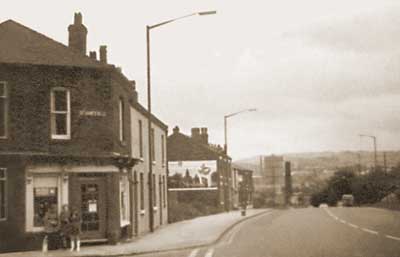 |
Hyde Rd, early 1970s. View looking south east towards Hyde and Werneth Low from the corner of St Anne's Rd. The corner shop is a grocery and off licence that was once occupied by William Temple. The site of Broomstair Colliery is off the picture to the right. The gasometer (gas holder) in the background is part of Hyde Gas Works located between Raglan St and the Lower Peak Forest Canal. William Temple was born at Easingwold, Raskelf, North Yorkshire in 1879/80 and he married Frances ‘Fanny’ Booth at Madeley, Shropshire, in 1902. She was born at Stirchley, Shropshire in 1878/79. The couple had two children, both born at Denton, Edith Mary (b.1903) and William (b.1908). |
Ashton Road
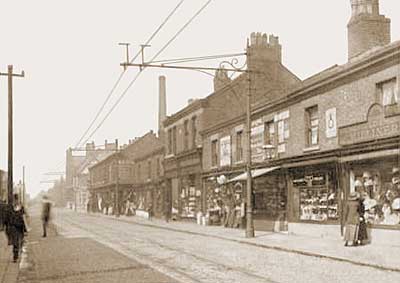 |
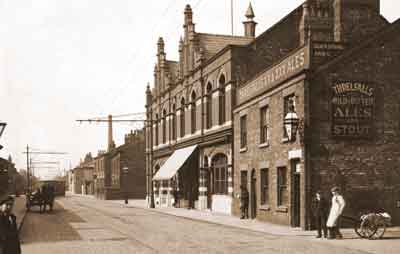 |
Ashton Rd, 1911. View looking northwards from near Crown Point. The tall factory chimney belongs to Joseph Howe & Sons, Hat Manufacturers, located between Annan St and Amelia St. In the distance, the Silver Springs public house and Denton & Haughton Co-operative Store can just be seen. | Denton & Haughton Co-operative Store and the Later the Silver Spring Arms became the Silver Springs. |
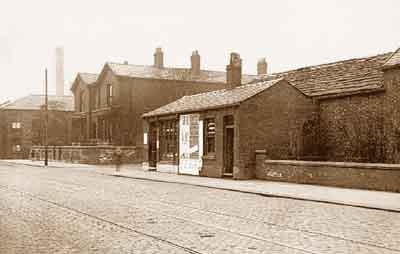 |
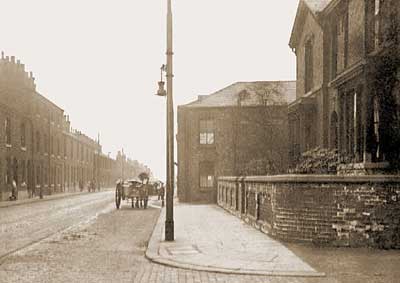 |
Ashton Rd, early 20th century View of two single-storey shops to the right of the entrance to Tame St. The factory on the left belongs to Samuel Hilton & Co (formerly Hilton & Spafford), hat trimmings manufacturers. By 1911 the nearer shop was occupied by Willie ‘William’ Dunkerley, a hairdresser while next door was occupied by Francis Booth, a boot and shoe repairer, and George Ogden, a clogger, was working here around this time. |
Ashton Rd, early 20th century. View looking northwards from the corner of Tame St. The two-wheeled, horse-drawn milk float is making its daily door-to-door delivery of fresh milk from large churns and the factory of Samuel Hilton & Co is in the background. |
Stockport Road
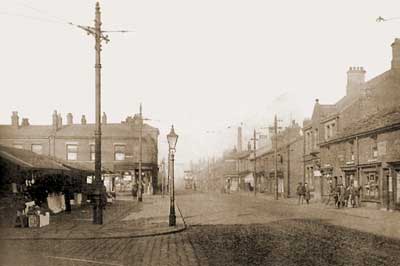 |
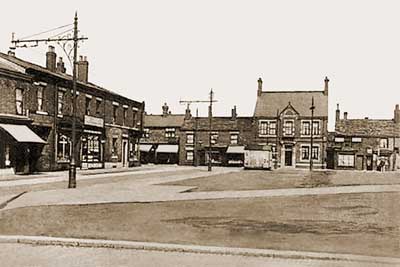 |
Stockport Rd, c.1920. View looking northwards towards Crown Point on Market Day. The entrance to Albert St is in the foreground on the left and Market Place stands between Albert St and Victoria St. The Gardeners Arms is on the right, set back between the shops. The tall factory chimney in the distance belongs to Joseph Howe & Sons, Hat Manufacturers. At this time the tramway connection between Haughton Green and Manchester was via Albert St and Market St and the tram lines can just be seen in the foreground on the left. The connection between Manchester and Haughton Green was via Market St and Victoria St. |
Market Place, c.1920. View looking eastwards from Market St towards Stockport Rd. By the time this photograph was taken, the wooden building, dating from c.1893, that housed market stalls had been demolished. The Gardeners Arms (now the Queen Vic) on Stockport Rd faces Market Place and Victoria St is on the left. The shops on Victoria St are part of Victoria Buildings and next to the shop on the left with a sun canopy there is an opening that provides access to the back of the King's Head. The stone lintel over this opening bears the date, '1869'. The tramway connection between Manchester and Haughton Green along Victoria St turned right at Stockport Rd to pass in front of the Gardeners Arms. |
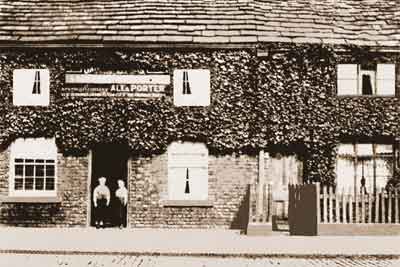 |
The original Gardeners Arms, pre c.1890. These cottages date from c.1750 but the use of the one on the left as a beerhouse began in the 1830s. In c.1890 the cottages were demolished and the present public house was erected on the site. |
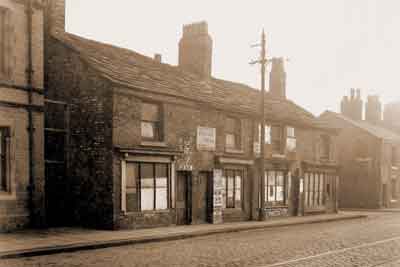 |
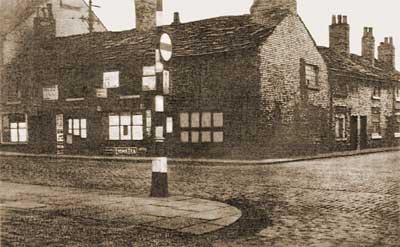 |
Gardeners Arms to Russell St, c.1934. Four flag-roofed shops between the Gardners Arms (left) and Russell St (right). Russell St is no longer extant and the site of the shops has been re-developed. |
Gardeners Arms to Russell St, c.1934. Four shops between the Gardeners Arms (left) and Russell St (right). |
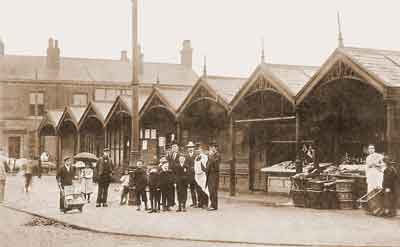 |
Market Place, early 20th century. View showing a row of market stalls along the Stockport Rd side with Albert St in the background. |
Trade directories demonstrate some confusion in the numbering of the shops between the Gardeners Arms and Russell St, a situation possibly brought about by the demolition and rebuilding of the Gardeners Arms to a larger size. After rebuilding, the four shops were numbered 21 to 27 and apparently No. 19 had been lost. Access to the back of the shops was via a ginnel at the side of the Gardeners Arms that opened out into a small courtyard.
Allowing for confusion in numbering, it is reasoned that the occupiers of the shops, where given, were:
1903No. 21, unknown; No. 23, Joseph Moss, newsagent; No. 25, Thomas Lockett, butcher; No. 27, Samuel Shaw, fried fish dealer.
1909No. 21, unknown; No. 23, John Greenhough, newsagent; No. 25, Thomas Lockett, butcher; No. 27, unknown.
1911No. 21, unknown; No. 23, John Greenhough, newsagent; No. 25, Thomas Lockett, butcher; No. 27, George Ingleby, greengrocer (Mr A Mitchell by 1913).
1930sNo. 21, Mitchell, greengrocer; No. 23, Hulme, newsagent; No. 25, Blower, confectioner; No. 27, Mason, second-hand goods dealer.
The 1939 Register for England and Wales makes no record of the four shops between the Gardeners Arms and the corner of Russell St as they had been demolished shortly before. Russell St is no longer extant.
The Gardeners Arms was a beer retailer and in 1903 the landlord was Mrs Mary Clarkson and in 1909 and 1911 it was James Lockett. The inhabitants of Nos. 1, 3 and 5 Russell St, shown in the photo, are unknown.
